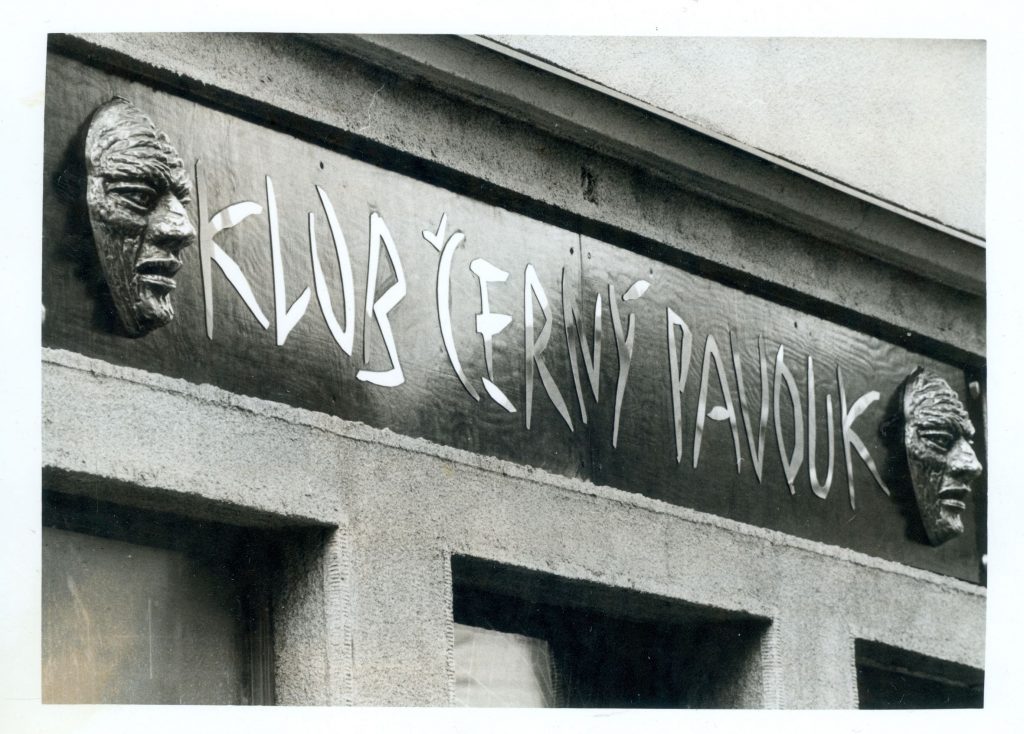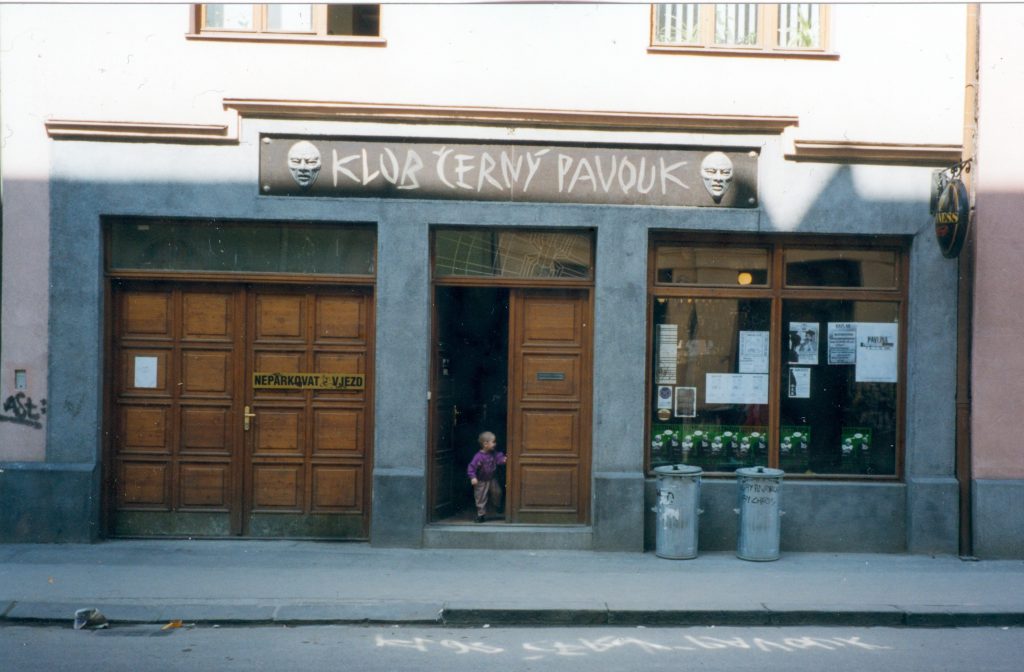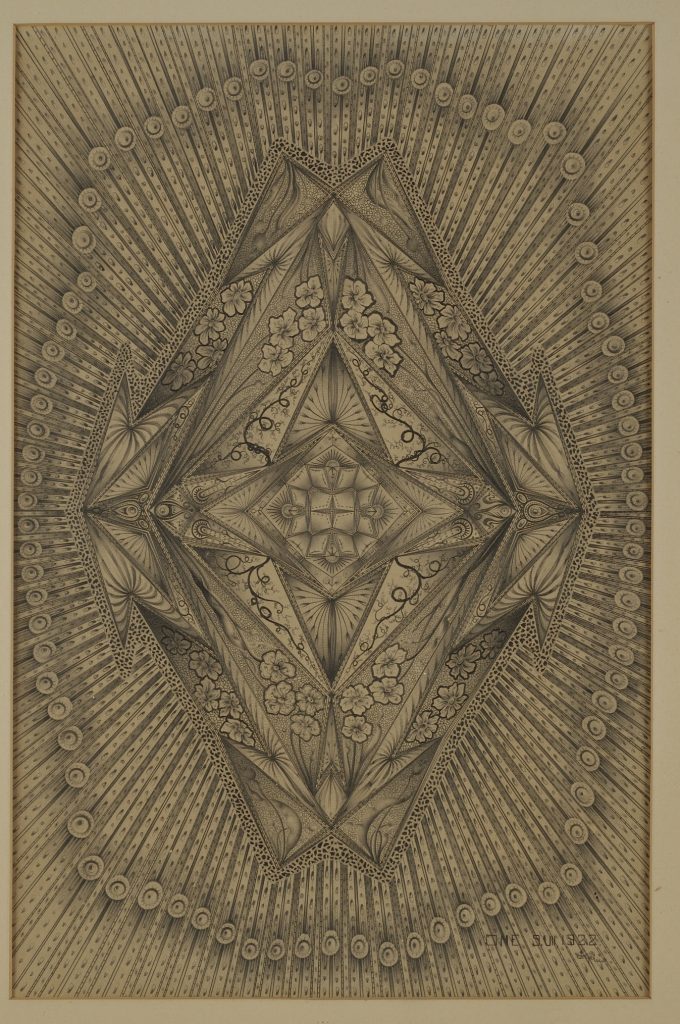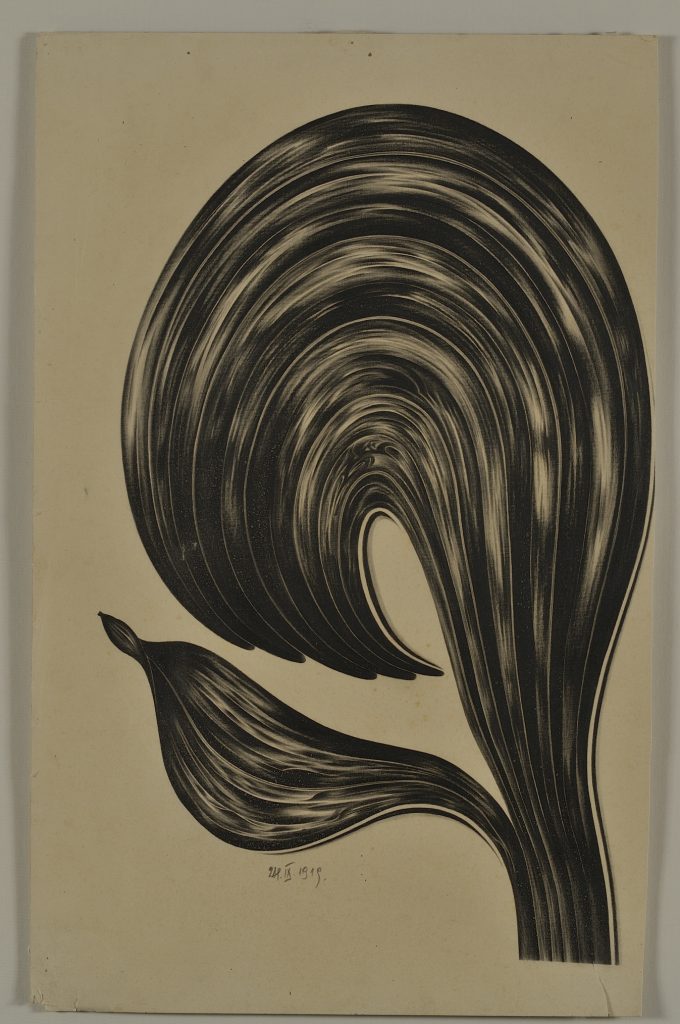The Collection of Eva Zdražilová and Jan Oravec – Mediumistic Art from the Czech Republic
For over a year I have enjoyed discussing and sharing images of mediumistic art with Eva Zdražilová and Jan Oravec, a dynamic couple from the Czech Republic who are on an exciting journey to rediscover the lost artworks of Josef Kocián (formerly Kotzian) and other Silesian spirit artists from his circle and beyond. Along the way they have documented new discoveries, met the people who once knew these pioneers of Czech spirit art and built an amazing art collection. In this exclusive interview they share the story of their collection and plans to celebrate these forgotten artists.
Can you tell me a little bit about your background? Have you both always been interested in art?
In 1994, five years after the fall of communism, we opened an antiquarian bookshop in the centre of Ostrava called ‘Black Spider’. It was also a club and a gallery where small theatrical performances, literary readings, musical evenings and exhibitions of contemporary art and photography happened.
We became interested in young contemporary artists, and we were most impressed by the work of the painter Jakub Špaňhel, who at the time was still a student at art school. We were immediately enthralled by his paintings and technique, so we became collectors of his work. Jakub is now a recognised academic painter whose work is greatly sought-after and at the top of the contemporary Czech art scene.
Our main interest at that time was in avant-garde books of the 1930s, and thanks to the internet, which allowed us to reach the whole world, new possibilities opened up for us. In 2005 we launched an Internet antiquarian bookshop, ‘108 Buddhas’, which focused on the Czech, Polish and Japanese avant-garde. It is still in operation today, but on a smaller scale. We also started a Czech Avant-Garde internet gallery in 2013, which focused on functionalist furniture and applied art.
When and why did you become interested in the spirit artists of Silesia and what was the first drawing that started your collection?
Since 1995, thanks to the antiquarian bookshop, we have travelled to see many private book collections in Moravia and Silesia. Along the way we began to discover Silesian spiritualism, which had been banned, or pushed out and forgotten in Czechoslovakia since 1950. After the fall of communism in 1989, publications about spiritualism began to appear again, but at the time there was little interest in these matters. In the last few years, however, interest has greatly increased, especially about the history of spiritualism in Czechoslovakia. The antiquarian bookshop opened opportunities for us to search for and collect old spiritualist books, magazines and publications published from 1883 to 1948, when communism began and the official publishing activities of the spiritualists ended.
In 1995, we initiated the shooting of a short documentary about the history of the Spiritualist House in Ostrava-Radvanice, which had been confiscated by the state in the 1950s and later served various purposes, the last being the Odboj Cinema. The house still stands today, but unfortunately it has never been returned to the Spiritistický spolek Bratrství (Spiritualist Brotherhood Society).
At the time, we had no idea that part of spiritualist practice was mediumistic drawing created by ‘drawing mediums’. We would like to thank the Czech surrealist Alena Nádvorníková, who was the first to show us this phenomenon when she curated the exhibition Art Brut in the Czech Lands in 2008.
A new world opened up for us and not long after we discovered the first drawings by Josef Kotzian (later known as Kocián), which captivated and engulfed us. Thus our journey began, and the collection of Silesian mediumistic artists began to develop. All of this history will be published over time on our new website www.czechmediumisticart.com .
Can you tell us a little bit about Silesia and what years the spirit artists were working? Do you think there is a reason that this was the home of such an extraordinary group of artists?
Silesia is a region located in the northeast of the Czech Republic. Silesian spiritualism began to form in the years 1900-1905 around Ostrava, Těšín, Třinec, Orlová, Bohumín, as well as in Horní Suchá, Dolní Bludovice, Bystřice nad Olší and Nýdek.
The spiritualism in the Ostrava district began to form mainly in Zárubek, but no longer exists today. The people here were mostly miners and also workers from Rothschild’s ironworks. They were people who worked hard. The first drawings that are documented date back to around 1905. These are the works of the carver Jan Kubíček from Místek in Moravia, followed by Richard Čech who was living in Zárubek, and Antonín Bílý, a worker from Vítkovice. Bílý was the first to paint mediumistic paintings on canvas with oil paints, unfortunately nothing has survived.
Under Austrian-Hungarian rule, the word ‘spiritualism’ was banned, so Silesian spiritualists founded the Building Association in 1911. This association built the Society House in Ostrava-Radvanice, which was completed in 1914. This was the first spiritualist house in Austria-Hungary. It was just two years later that Jan Samolej, a locksmith by profession, began to create the first mediumistic drawings, followed by Josef Kotzian in 1918.
Soon after the emergence of the Czech Republic in 1918, the Spiritistický spolek Bratrství (Spiritualist Brotherhood Society) was founded in 1919 and subsequently published the first issue of a magazine called Spiritistická Revue (Spiritualist Revue). About twelve mediumistic artists gathered around the society, and as a group exhibited all over Europe, particularly in the latter twenty years of the society’s activities. Today, the Brotherhood is beginning to be a focus for the history of Czech mediumistic drawing, and the Silesian mediumistic artists are becoming recognized, especially Kotzian, Krygel and Samolej.
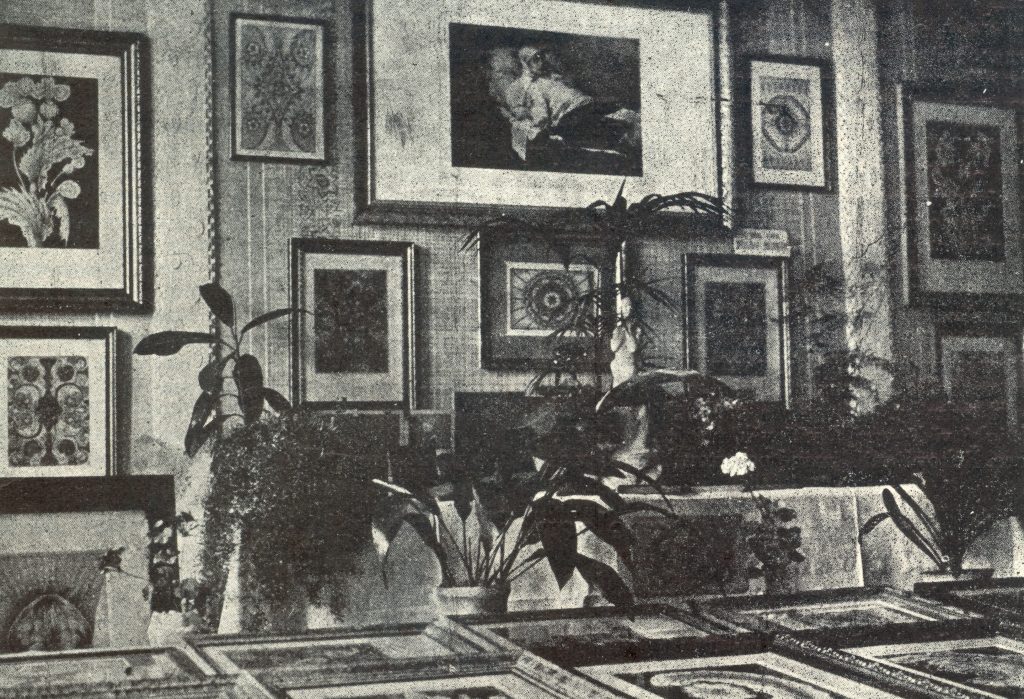
What is very special about Silesian mediumistic drawing is that the mediumistic artists could work on one drawing for up to hundred hours. When the influence ended in one session, they were able to later reconnect and continue drawing. They were convinced, and were told many times during the seance, that only morally clean people could connect to the energy of the higher spirits. In other words, connect with those who paint and draw. The Brotherhood had tens of thousands of supporters, but there weren’t many official members. Only vegetarians, non-drinkers and non-smokers could become members.
The old spiritualists whom we met and talked with for a long time are convinced that it was thanks to this committed effort that such wonderful and unique drawings were created around the Brotherhood, which confirms our assumption that there is something very special about these drawings. These artworks are some of the most beautiful and strong drawings which have been called ‘Windows into the unconscious’. They have depth and incredible energy.
It all ended with the beginning of World War II. In 1939 the Nazis confiscated the archives of the Spiritistická Revue magazine which was led for 30 years by Jan Kuchař and Jan Rösner, who until their death lived together in the editorial office house. Afterwards it continued as the Psychická Revue. Shortly after the war, Jan Samolej died in 1946. Unfortunately only a few of his drawings have survived.

Editor of Spiritistická Revue – Jan Rösner 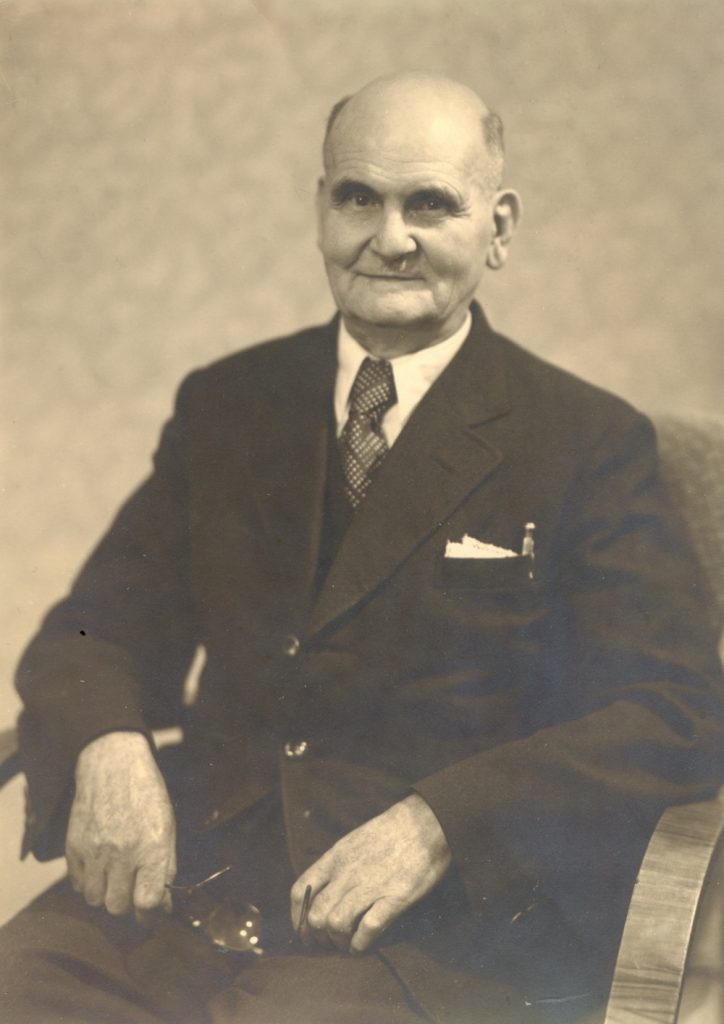
Editor of Spiritistická Revue – Jan Kuchař
What made you realise that these artists needed researching, and prompted you on your journey to discover more about them and to find more examples of their work?
When we first saw the drawings by Josef Kotzian, it was a strong inspiration for us to find out more about these drawings and the mediumistic world. We thought it would be an easy and fast journey. Today we know how naive we were. It’s very complicated and slow, but all the more beautiful, because on this journey we have met, and continue to meet, wonderful and pure people – ninety-year-old vegetarians, non-drinkers and non-smokers who, with their parents, were associated with the Spiritualists Brotherhood Society.
We started our investigation sixty years after the end of the activities of the Brotherhood, and almost fifty years after the death of the most important Silesian mediumistic artist, Josef Kotzian, who changed his name in 1945 to Kocián. Our journey continues to this day and we would like to thank, and name here, all the living witnesses that have helped us, but most of them do not want that. We will mention Mr. Miloš Grossmann, born in 1931, who guided the way for us. An amazing witness and a wonderful man.
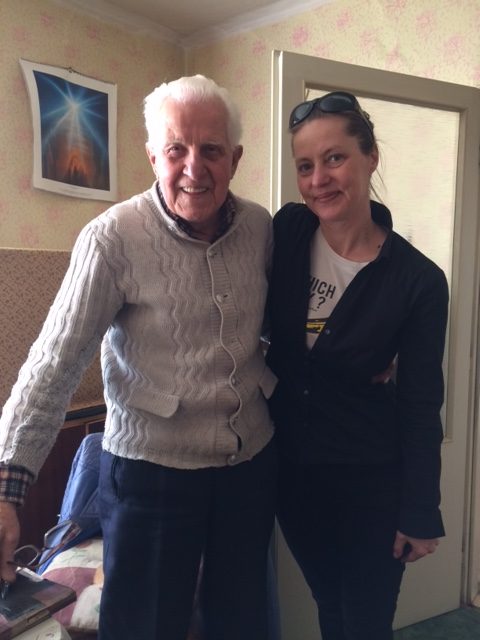
Miloš was the first to point out to us that Josef Kotzian had a student in 1947-1950. This pupil was Josef Labaj, who Kotzian helped “tidy up” his drawing. He also taught him to connect with the one who paints, the spirit Solferino, with whom Josef Kotzian probably first connected in 1918, when he began to sign his drawings with this signature. We later discovered that Labaj continued to work in secrecy throughout communism. In the mountains, where he lived with his family, he also held spiritistic seances and continued to connect and paint.
I have seen some of the photographs documenting your research trips to find work by artists like Labaj – what have been some of your memorable moments so far?
The biggest surprise for us was the finding that Josef Kotzian had a student, as only a few people from the Brotherhood knew this. So we started looking and discovered a house in the mountains near the Polish border, where Josef Labaj lived his whole life until 2002, when he died.
The room where he painted and in which the spirit seances took place until 1992, was locked after his death. We were the first to enter this room in over seventeen years. It was as if time had stopped there. An unfinished mediumistic drawing, along with crayons and glasses, were the only things laying on the table there. We are grateful that we were able to obtain and save his estate, and according to his notes, we own almost all the drawings he created. Some of his drawings were framed and hung in the house. After removing the paintings, we noticed the imprints left on the walls as seen in the photo below.
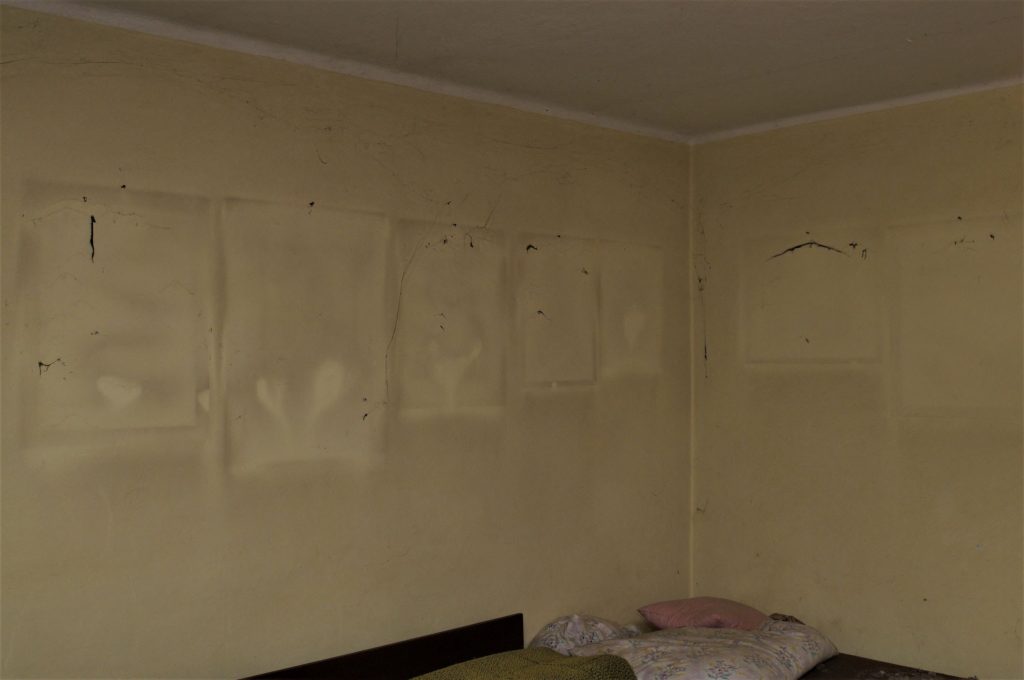
Room after removing the drawings in July 2019 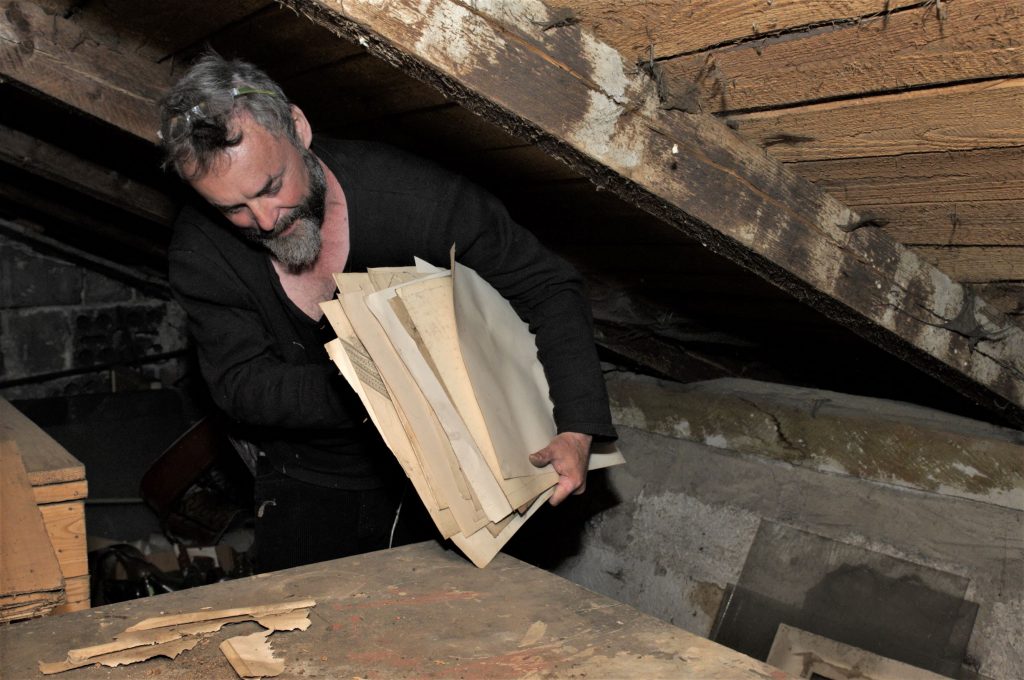
Jan and Eva’s discovery of Labaj drawings in the attic in 2019
Labaj started painting in 1947 and created about 70 mediumistic drawings during his lifetime, but a large group remained unfinished, mostly from 1947-1955. We found several of these unfinished drawings scattered on the floor and even in the attic. We will gradually publish more about these findings on our website www.czechmediumisticart.com .
Which artists are you particularly interested in? Are they all represented in your collection or are there some that you are still trying to find? Are some artists easier to find than others?
At the moment almost nothing can be found. We try to plot all the mediumistic artists around the Brotherhood, even in reproductions from period magazines and books. Today, it is practically impossible to get something from Jan Samolej, Josef Krygel or Jan Kubíček.
The world-famous artist and filmmaker Jan Švankmajer has several of these artworks in his collection. He helped us a lot and enabled us to completely document his collection of Silesian artists. When we met with him, we were very surprised at how greatly he values mediumistic drawing and puts it above classical art.
Of course, there are also several artists which we are also looking for outside Silesia. In particular Václav Groul, Adéla Ducháčová, Anna Haskel, F. Bergmanová, J.F. Pecka and Jindřich Krejčí. There are also many amazing mediumistic artists in Nová Paka who are well known, including H. Hasman, J. Kovář, J. Smetana, J. Tóna, F. Rofelin and others.
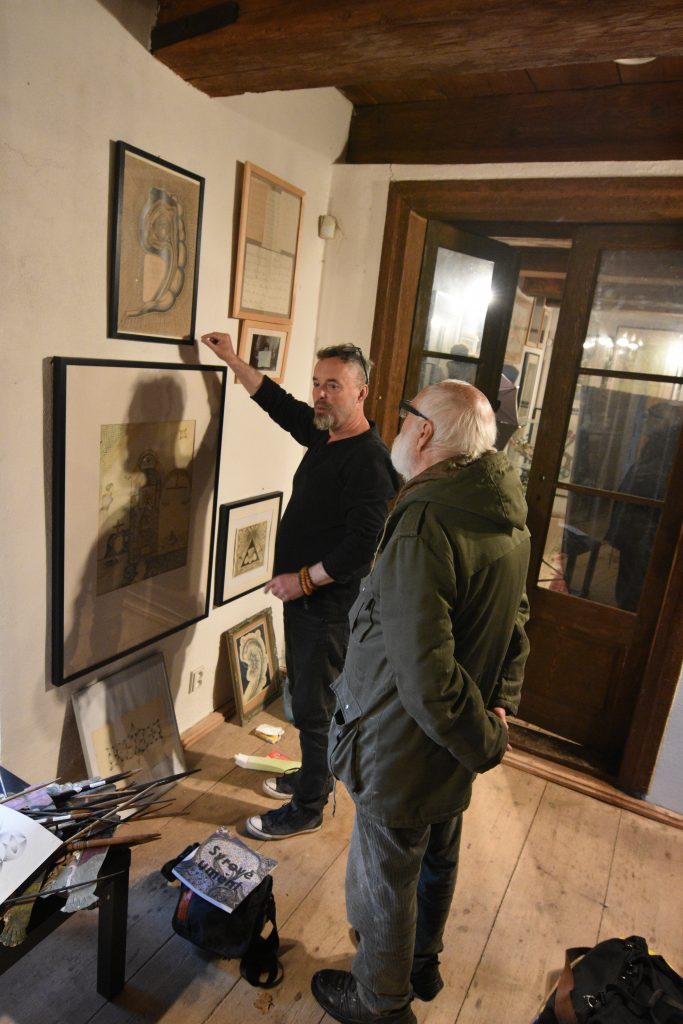
You have met several spiritualist families who knew the artists such as Josef Kotzian. Did they give you an insight into the artist’s lives and what their families thought about their art?
It took us a long time to discover Josef Kotzian’s family. It was very difficult, because as we found out, he had no children, and distant relatives do not remember much. From the information we have gradually acquired, it is probable that the works left in his estate were destroyed, and sadly, therefore irretrievably lost. Thanks to his family, however, we discovered one important fact that Josef Kotzian did not die in 1960, as has been written so far, but only in the summer of 1964.
We met many people who knew Josef Kotzian and Jan Samolej personally, but even so, there is very little information or preserved photographs. The vast majority of spiritualists died before the war, so no one who was a direct participant can tell us more. For many of them, we have to rely on period materials such as books and magazines.
People were also afraid to talk about it in their families. Everything remained only in memories, and after 1989 there was no interest in spiritualism. We apologize for repeating ourselves, but it is difficult for people who did not live in the communist totalitarian regime to understand. Spiritualists and their families were afraid to talk about these things, everything was clandestine and they met secretly. Spiritualistic activity was persecuted by the State police, and everyone was threatened with imprisonment if they went against the State regime.
Unfortunately, it is mostly too late to hear personal memories from the original spiritualists, but there still are their families who maintain a connection to the spiritualist past. Most of them have mediumistic drawings on the walls, which they value very much. We believe that more new information and even other names may appear.
Do you have a favourite artwork or a picture that is particularly meaningful to you?
We are fascinated by every mediumistic drawing, but we are strongly attracted to the two shown here by Kotzian. It’s about the energy that radiates from these drawings, but of course that can affect everyone differently. This energy is non-transferable, so you need to hold the drawing in your hands and see all the details and let it affect you personally.
You are planning a book and creating a website devoted to the spirit artists of Silesia, how is that going, and when do you think the book will be published? Have you any other hopes and aspirations for your collection? Is there anything you would like to say to the other collectors of Silesian mediumistic art?
Our website www.czechmediumisticart.com is dedicated to Silesian mediumistic artists and the history of the Spiritualist Brotherhood Society. It will be continually updated because we have a lot of material that we would like to publish: photographs, documents, publications, period artifacts, etc.
The forthcoming book with the working title “Spiritist Mediumistic Drawing in Silesia 1905-2002” is almost finished and by the end of 2020 all photographic and textual materials should be completed and prepared.
According to the latest information, the cultural situation is currently complicated and it will therefore be very problematic to publish a book. We have photographed about 250 drawings by Silesian mediumistic artists, so the publication will be very extensive. The budget for publishing the book is estimated to be 30,000-40,000 Euros. We are currently thinking about how and where to obtain these funds.
We are open to any ideas or proposals, so if any of the readers would like to share their experience or otherwise help us, we will be very happy to hear from then. A transparent bank account will also be placed on our website, to which it will be possible to contribute funds.
It is our wish that the publication contains all available drawings by the Silesian artists. We know of several drawings owned by foreign collectors, so we would like to take advantage of this interview and ask them, if they agree, to place their drawings in our book. They can contact us by email: info@czechmediumisticart.com . Our aim is to present a complete body of work that will show all the preserved Silesian mediumistic artworks. Therefore, it would be a pity if some of them are missing.
At this time, our priority is to get the site up and running and complete the book. We do not yet have a precise plan regarding an exhibition. Our secret wish is to create a small museum of the history of spiritualism in Radvanice. We are currently looking for suitable premises. Of course, everything now depends on the financial support. We want to leave everything open and see what happens next….
This interview with Eva Zdražilová and Jan Oravec took place in August 2020 by Vivienne Roberts. For more information on their exceptional collection please visit their website on www.czechmediumisticart.com . All images are copyright Eva Zdražilová and Jan Oravec.
More from our Discovering Collections series can be seen here.
